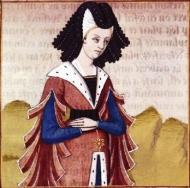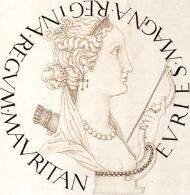誰がJulius Caesarとデートしましたか?
Postumia 日付の Julius Caesar ? から ?. まで
Postumia 日付の Julius Caesar ? から ?. まで
Mamurra 日付の Julius Caesar ? から ?. まで
Mucia Tertia 日付の Julius Caesar ? から ?. まで
Lollia 日付の Julius Caesar ? から ?. まで
Servilia 日付の Julius Caesar ? から ?. まで[:a {:href "https://erenow.net/ancient/thejoyofsexus/25.php", :target "_blank"} [:i.fa.fa-external-link {:aria-hidden "true"}]]
Cossutia 日付の Julius Caesar ? から ?. まで
Sempronia 日付の Julius Caesar ? から ?. まで
Eunoë 日付の Julius Caesar ? から ?. まで
クローディア 日付の Julius Caesar ? から ?. まで
Tertulla 日付の Julius Caesar ? から ?. まで
Nysa 日付の Julius Caesar ? から ?. まで
Cleopatra 日付の Julius Caesar から . まで 年齢差は 30 年 6 か月 10 日.
Julius Caesar

Gaius Julius Caesar (12 or 13 July 100 BC – 15 March 44 BC) was a Roman general and statesman. A member of the First Triumvirate, Caesar led the Roman armies in the Gallic Wars before defeating his political rival Pompey in a civil war. He subsequently became dictator from 49 BC until his assassination in 44 BC. Caesar played a critical role in the events that led to the demise of the Roman Republic and the rise of the Roman Empire.
In 60 BC, Caesar, Crassus, and Pompey formed the First Triumvirate, an informal political alliance that dominated Roman politics for several years. Their attempts to amass political power were opposed by many in the Senate, among them Cato the Younger with the private support of Cicero. Caesar rose to become one of the most powerful politicians in the Roman Republic through a string of military victories in the Gallic Wars, completed by 51 BC, which greatly extended Roman territory. During this time, he both invaded Britain and built a bridge across the river Rhine. These achievements and the support of his veteran army threatened to eclipse the standing of Pompey. The alliance between Caesar and Pompey slowly broke down and, by 50 BC, Pompey had realigned himself with the Senate. With his command expiring and the Gallic Wars largely concluded, the Senate ordered Caesar to step down from his military command and return to Rome. In early January 49 BC, Caesar openly defied the Senate by crossing the Rubicon and marching towards Rome at the head of an army. This began Caesar's civil war, which he won, leaving him in a position of near-unchallenged power and influence in 45 BC.
After assuming control of government and pardoning many of his enemies, Caesar set upon a vigorous reform and building programme. He created the Julian calendar to replace the republican lunisolar calendar, reduced the size of the grain dole, settled his veterans in new overseas colonies, greatly increased the size of the Senate, and extended citizenship to communities in Spain and what is now northern Italy. In early 44 BC, he was proclaimed "dictator for life" (dictator perpetuo). Fearful of his power, domination of the state, and the possibility that he might make himself king, a group of senators led by Brutus and Cassius assassinated Caesar on the Ides of March (15 March) 44 BC. A new series of civil wars broke out and the constitutional government of the Republic was never fully restored. Caesar's great-nephew and adoptive heir Octavian, later known as Augustus, rose to sole power after defeating his opponents thirteen years later. Octavian then set about solidifying his power, transforming the Republic into the Roman Empire.
Caesar was an accomplished author and historian; much of his life is known from his own accounts of his military campaigns. Other contemporary sources include the letters and speeches of Cicero and the historical writings of Sallust. Later biographies of Caesar by Suetonius and Plutarch are also important sources. Caesar is considered by many historians to be one of the greatest military commanders in history. His cognomen was subsequently adopted as a synonym for "emperor"; the title "Caesar" was used throughout the Roman Empire, and gave rise to modern descendants such as Kaiser and Tsar. He has frequently appeared in literary and artistic works.
続きを読む...Postumia
Julius Caesar

Postumia
Julius Caesar

Mamurra
Mamurra (fl. 1st century BC) was a Roman military officer who served under Julius Caesar.
続きを読む...Julius Caesar

Mucia Tertia
Múcia Tércia (em latim Mucia Tertia) foi uma matrona romana que viveu no século I a.C. Era filha de Quinto Múcio Cévola, pontífice máximo (pontifex maximus),[carece de fontes?] assassinado pela facção de Caio Mário em 86 a.C., e de Licínia Crassa, que se divorciou do seu pai para se casar com Quinto Cecílio Metelo Nepos, num escândalo mencionado em várias fontes. O seu nome indica que era uma terceira filha, de acordo com a convenção romana de nomes.
O primeiro marido de Múcia Tércia foi Caio Mário, o Jovem, cônsul em 82 a.C. no pico da guerra civil contra os Optimates liderados por Lúcio Cornélio Sula. Pouco depois, o conflito acabou com o suicídio do jovem Mário e com a vitória de Sulla. Múcia, como viúva de um proscrito, ficou proibida de voltar a casar. No entanto, em 81 a.C., Sula mudou de ideias e patrocinou o seu casamento com Pompeu. Desta união nasceram três crianças: Pompeu, o Jovem,[carece de fontes?] Sexto Pompeu e Pompéia Magna (que casou-se com Fausto Cornélio Sula).
Entre 76 e 61 a.C., Pompeu passou muito tempo fora de Roma, combatendo os piratas do Mediterrâneo, a rebelião de Sertório na Hispânia e o rei Mitrídates VI do Ponto. Quando regressou definitivamente a casa, enviou uma carta de divórcio a Mucia Tertia; Plutarco menciona uma correspondência pessoal de Cícero que teria o motivo desta separação. Múcia Tércia desaparece então das fontes e a data da sua morte é incerta. Muitas fontes afirmam que Júlio César era amante de Múcia, e, portanto, o pivô dessa separação.
続きを読む...Julius Caesar

Lollia
Lollia was an Ancient Roman noblewoman. She was the wife of Roman general Aulus Gabinius. She was also a mistress of Julius Caesar.
続きを読む...Julius Caesar

Servilia

Серви́лия Ста́ршая (лат. Servilia Maior; около 100 — после 42 гг. до н. э.) — римская матрона, известная в первую очередь как мать Марка Юния Брута. Она принадлежала к нобилитету и была женой двух знатных плебеев из рода Юниев: Марка Юния Брута (народного трибуна 83 года до н. э.) и Децима Юния Силана (консула 61 года до н. э.). Долгое время состояла во внебрачной связи с Гаем Юлием Цезарем, так что некоторые античные авторы именно Цезаря называют настоящим отцом её единственного сына.
続きを読む...Julius Caesar

Cossutia

Cosucia (en latín, Cossutia; fl. Siglo I a. C.) fue una noble romana.
No se sabe nada de su familia, tan sólo que formaba parte de la gens Cosucia, una familia de la nobleza ecuestre de Roma y probablemente originaria de Corinto. Según Suetonio estuvo prometida a Julio César en 84 a. C., mientras éste llevaba la toga pretexta. La repudió un año más tarde para casarse con Cornelia, hija de Lucio Cornelio Cinna, cónsul en 83 a. C.
続きを読む...Julius Caesar

Sempronia

Sempronia war eine römische Aristokratin der späten Republik. Sie war die Frau des Decimus Iunius Brutus, Konsul des Jahres 77 v. Chr., und nach Sallust aktive Teilnehmerin – zumindest Mitwisserin – an der catilinarischen Verschwörung.
続きを読む...Julius Caesar

Eunoë

Eunoë Maura was the wife of Bogudes, King of Western Mauretania. Her name has also been spelled Euries or Euryes or Eunoa.
続きを読む...Julius Caesar

クローディア

Кло́дия Пу́льхра Те́рция (урождённая Кла́вдия Пульхра Терция; сменила имя на «Клодия»; часто упоминается как просто Клодия, иногда — Клодия Мете́лла или Клоди́лла; лат. Clodia Pulchra Tertia; родилась, по одной из версий, в 95 году до н. э. — умерла не ранее 44 года до н. э.) — римская матрона, приходившаяся старшей сестрой мятежному народному трибуну 58 года до н. э. Клодию. Предположительно, могла быть причастной к отравлению собственного супруга и консуляра Квинта Цецилия Метелла Целера.
По распространённому в современной историографии мнению, послужила прообразом Лесбии в произведениях римского поэта Гая Валерия Катулла.
続きを読む...Julius Caesar

Tertulla
Julius Caesar

Nysa
Ниса (др.-греч. Νύσα) — дочь царя Вифинии Никомеда IV (по другим, видимо, устаревшим сведениям — Никомеда III), жившая в I веке до н. э.
続きを読む...Julius Caesar

Cleopatra

クレオパトラ7世フィロパトル(ギリシア語: Κλεοπάτρα Ζ' Φιλοπάτωρ、ラテン語: Cleopatra VII Philopator、紀元前69年 - 紀元前30年)は、古代エジプトプトレマイオス朝ファラオ(女王)。
一般的に「クレオパトラ」と言えば彼女を指すことが多く、プトレマイオス朝の最後の女王で、ガイウス・ユリウス・カエサルやマルクス・アントニウスらとのロマンスで知られる。4人の子供を妊娠・出産した。有名なのはカエサルとのこ、カエサリオンである。王朝自体がアレクサンドロス3世の部下プトレマイオス1世による支配から始まったため、クレオパトラもギリシア系である。
「クレオパトラ」は、古代ギリシア語クレオパトロス(父の栄光)の女性形である。「絶世の美女」として知られ、世界三大美人の一人である。ただし、クレオパトラの肖像は治世当時、アントニウスが発行したとされている硬貨に横顔が残されているのみであり、この評価は後世の作り話だとの説がある(#人物節を参照)が、妹のアルシノエ4世の復元図から姉のクレオパトラも美しかったとする説もある。
なお、アレクサンドリアを襲った365年のクレタ地震のため、当時の史料は残っておらず、プルタルコスやスエトニウスら後世の歴史家による記録に負うが、その正確性には疑問が残る。
続きを読む...